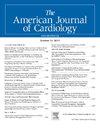Clinical Outcomes for Postinfarct Ventricular Septal Defect Repair in a Large State-Wide Surgical Registry
IF 2.3
3区 医学
Q2 CARDIAC & CARDIOVASCULAR SYSTEMS
引用次数: 0
Abstract
Ventricular septal defect (VSD) is a life-threatening complication occurring after delayed presentation of acute myocardial infarction (AMI). We assessed clinical characteristics based on mortality following surgical repair of post-AMI VSD and evaluated trends of mortality, mechanical circulatory support (MCS) device use, and surgical approach. We included all patients who had surgical VSD repair following AMI who were included in a regional quality collaborative from May 2008 through January 2020. The primary outcome was in-hospital mortality. A univariate logistic regression model was utilized for each clinical variable on in-hospital mortality, while a multivariable model was used on age and variables that showed significant association (p <0.05) in the univariable model. Of the 79 patients who received repair, 32 (41%) were ≥70 years, 49 (62%) were male, and 28 (35%) died. The preoperative mean ejection fraction was 35%. Cardiogenic shock (CS) was observed in 53% (alive vs dead: 39% vs 79%, p = 0.001), while 6% required cardiopulmonary resuscitation (alive vs dead: 2% vs 14%, p = 0.05). MCS devices including extracorporeal membrane oxygenation were used in 22% (alive vs dead: 4% vs 54%, p <0.001). Emergent surgery was performed in 37% (alive vs dead: 18% vs 71%, p <0.001), concomitant aortic valve replacement in 10% (alive vs dead: 11% vs 9%, p = 0.029), and delayed intervention (beyond 7 days) in 44% (alive vs dead: 57% vs 21%, p = 0.002). Intraoperatively, blood products were used in 49% (alive vs dead: 45% vs 57%, p = 0.005). Following repair, 22% suffered from renal failure (alive vs dead: 19% vs 48%, p = 0.021). Patients who experienced delayed intervention had higher survival rates probably related to survival bias. Patients who suffered in-hospital mortality were more likely to have CS and to require MCS. Improvement in patient selection by a “Heart Team” approach and new therapeutic options are needed as part of advanced care for mechanical complications of AMI.
梗死后室间隔缺损修复的临床结果在全国范围内的大型外科登记。
室间隔缺损(VSD)是急性心肌梗死(AMI)延迟表现后发生的危及生命的并发症。我们根据ami后室间隔缺损手术修复后的死亡率评估临床特征,并评估死亡率、机械循环支持(MCS)装置使用和手术入路的趋势。我们纳入了2008年5月至2020年1月区域质量协作的所有AMI术后VSD手术修复患者。主要终点是住院死亡率。对住院死亡率的每个临床变量使用单变量logistic回归模型,而对年龄和显示显着相关性的变量使用多变量模型(p
本文章由计算机程序翻译,如有差异,请以英文原文为准。
求助全文
约1分钟内获得全文
求助全文
来源期刊

American Journal of Cardiology
医学-心血管系统
CiteScore
4.00
自引率
3.60%
发文量
698
审稿时长
33 days
期刊介绍:
Published 24 times a year, The American Journal of Cardiology® is an independent journal designed for cardiovascular disease specialists and internists with a subspecialty in cardiology throughout the world. AJC is an independent, scientific, peer-reviewed journal of original articles that focus on the practical, clinical approach to the diagnosis and treatment of cardiovascular disease. AJC has one of the fastest acceptance to publication times in Cardiology. Features report on systemic hypertension, methodology, drugs, pacing, arrhythmia, preventive cardiology, congestive heart failure, valvular heart disease, congenital heart disease, and cardiomyopathy. Also included are editorials, readers'' comments, and symposia.
 求助内容:
求助内容: 应助结果提醒方式:
应助结果提醒方式:


